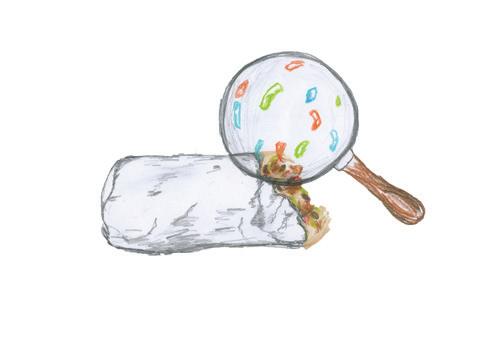
3 minute read
What Are We Eating?
from February 2016
by Le Journal
We Are What We Eat
With the rise of E. coli from various Chipotle locations, Americans need to learn to be more careful and conscious of what they are eating. BY NATALIE SOPYLA FEATURES EDITOR
Advertisement
Nowadays, it seems like no one knows where their food comes from. The Food and Drug Administration regulates anything and everything that Americans consume, but even that doesn’t seem to be enough to stop foodborne illness. With the recent outbreak of E. coli at Chipotle restaurants around the country, it’s clear that even society’s favorite foods aren’t safe from contamination. People are not paying attention to what they eat. Now more than ever, the public needs to learn to be proactive, to ask questions and figure out exactly what they are putting into their bodies.
For one thing, people need to know exactly how much processing their food has gone through and understand the problems that arise with mass production of food. Ever wondered how McDonald’s gets its french fries to taste exactly the same, every time? According to howstuffworks.com, the food sold at fast food chains is actually produced in a factory and frozen; in other words, none of it is made from scratch in the restaurant. In addition, factories add artificial and natural flavors to ensure that the taste of each individual product is consistent. These flavors are manufactured, unsurprisingly, in a factory of their own.
If the fact that the “food” in chain restaurants is manufactured isn’t stomach ache-inducing enough, consider the problems that arise when the factories where food is manufactured aren’t well inspected. One well-known case of this occurring was in the recent listeria outbreak in various Blue Bell Ice Cream products. Listeria is an infection brought on by consumption of contaminated foods, and can cause death in some cases. The cause of the contamination was linked to several of Blue Bell’s plants in Texas and Oklahoma, where sanitation was not up to par, according to CNN’s website. This is proof of the danger of consuming factory produced foods, and if it’s not enough to make people think twice about what they are eating, humanity is heading towards an unhealthy future.
Another important factor to consider is where people are getting their meats and produce from. Just as there are factories that manufacture pre-cooked foods, there are factories that raise farm animals too, and they are equally terrible. According to the website for the American Society for the Prevention of Cruelty to Animals, factory farms pack animals into pens so tight that they can barely move. These animals are not able to go outside or roam freely and often sit in their own waste their whole lives, making these farms a breeding ground for E.coli and salmonella.
But E. coli is not limited to meats; vegetables can be just as easily infected. In 2006, an outbreak of E. coli was detected in bagged spinach that infected over 100 people and killed one person. While vegetables are not commonly infected on their own, they can be infected if they are cross contaminated with bacteria strains from animals, from runoff water, or from farm equipment. While these cases are very rare due to the nature of E.coli bacteria, it is definitely possible that a contaminated vegetable could have been the cause of Chipotle’s outbreak. Fruits and vegetables are the food groups that are supposed to be “healthy,” yet even they are not safe from foodborne illness.
While Kansas City and the other affected cities wait for this to blow over, there are a number of things that people can do to ensure the safety of their food. When buying meats, eggs or dairy at the store, the ASPCA recommends looking for labels on packages that say things like “Certified Human,” “Animal Welfare Approved” or “Global Animal Partnership” to ensure that they are buying products that are clean and were well cared for. People should also make sure that their kitchen habits are sanitary; thoroughly washing all produce items is a must, as well as avoiding cross contamination by using separate cutting boards for meat and vegetables. The ultimate lesson people need to learn from this is to think before they eat.
(Illustration by AP art studentjunior Mayme Loyd)
BY THE NUMBERS:
E. COLI OUTBREAK
53
total number of individuals affected by E.coli in America
9
number of states that have experienced
E. coli outbreaks
20
number of individuals hospitalized, but no deaths have occurred









